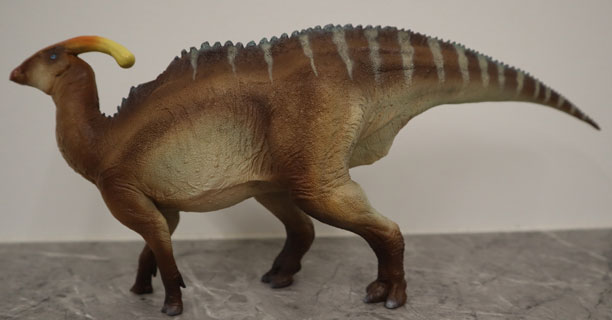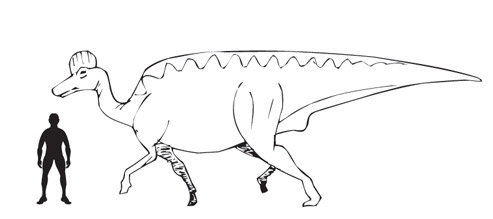What sort of sounds did Dinosaurs Make?
No dinosaur film or TV documentary is complete without the roaring and bellowing sounds of the animals being portrayed. However, the noises and calls added by the dubbing team to the soundtrack are based on assumptions and scientific guesswork. The sound an animal makes is not preserved within the fossil record, so palaeontologists have to turn detective to try to work out what sort of sounds long extinct creatures would have made.
Dinosaur Sounds
Most reptile species around today are largely silent, however, herpetologists (people who study reptiles) are beginning to understand more about the complex communication between individuals of the same species and how reptiles react to their surroundings using their senses. For example, for many years, scientists thought that as snakes show no signs of an external ear structure they were deaf. However, research has shown that snakes are sensitive to vibrations of the ground and that they do possess a sense of hearing although the mode of its operation is unique to the Squamata order. The quadrate, a bone located towards the back of the skull is able to respond to airborne sounds which are transmitted through the skin. The vibrations that are produced are transmitted to the cochlea, converted to electrical signals which can then be interpreted by the brain. It is believed that snakes can pick up low frequency airborne sounds in this manner, having a hearing range of around middle C to high C. Indeed, some scientists have claimed that snakes are more sensitive to sounds in this frequency range than domestic cats.
Hearing in the Squamata Order
Snakes are related to lizards and lizards have a sense of hearing so it would be logical to assume that this sense has not been lost by the snakes, merely that the external ear has disappeared and modification to the receipt of sounds has evolved.
The noisiest reptiles in the modern world are the Crocodilians – the crocodiles, alligators, caymans and gharials. The noise levels generated varies between the species, from hissing noises that are made as a threat gesture to the low-frequency sounds made by males to attract mates in the breeding season. A lot of work has been done on the sounds made by American Alligators. Studies have shown that the sounds produced by the males (called bulls), varies depending on the size of the animal. Deeper and more penetrating sounds are made by the larger males. The larger the male the louder the sound and the greater distance it will travel.

PNSO Wyatt the Parasaurolophus dinosaur model in lateral view, a stunning replica of a Late Cretaceous duck-billed dinosaur. The hollow crests of these dinosaurs could have helped them to vocalise. Picture credit: Everything Dinosaur.
Picture credit: Everything Dinosaur
To view the PNSO range of models in stock at Everything Dinosaur including replicas of hadrosaurs: PNSO Museum Quality Dinosaur Models.
Alligators have no vocal cords as such but make noise by sucking air into their lungs and then forcing it out again. The low frequency sounds produced are so intense that the water dances on their backs due to the vibration. The sounds travel for long distances underwater (water is a better transmitter of sound than air).
Animals can use sounds for a variety of purposes, to keep in touch with their family group, to call to their parents (such as the beeping noise made by baby crocodiles), to ward off rivals and to attract a mate. This kind of communication amongst dinosaurs would have been common place, however, the fossil record provides little actual evidence of the sounds dinosaurs made or indeed how their sense of hearing would have operated.
It is not clear whether dinosaurs had vocal cords, soft tissues are rarely preserved as fossils, perhaps the recently discovered Hadrosaur mummy, nicknamed “Dakota” will shed some further light on the sounds dinosaurs were capable of producing.
To read more about the discovery of this dinosaur fossil complete with skin and some internal organs preserved: Dinosaur Mummy unlocks Duck-Billed Dinosaur Secrets.
How do Birds Make Sounds?
Birds, like crocodiles are relatively close relatives of dinosaurs. They can produce an extraordinary arrange of sounds, from beautiful, lilting birdsong to harsh cries and shrieks depending on the species. Birds can also vary the tone and pitch of the noises they produce as well as controlling the volume of their calls. Birds do possess a larynx, a small organ located near the top of the windpipe, but it is believed to have only a rudimentary role in sound creation, merely helping to control the flow of air. The sounds we make are made by the larynx and our vocal cords, birds have a specialised sound producing organ (called the syrinx) at the base of their windpipe (trachea). It is from the syrinx and the elasticated membranes within it that the sounds birds make are largely controlled.
Dinosaur Sounds
It has been assumed by scientists that vocalisation would have been very important to dinosaurs, with different species, and indeed different individuals within a species making distinct sounds. The cheeks and beaks found in many ornithopods such as iguanodonts would have altered and helped modify the sounds these animals produced. Perhaps, quieter, frequent chirps between herd members to keep in contact with each other and then louder, bellows to warn of danger. The larger the animal the lower the frequency of the sound likely to be produced. Compsognathus, a small bipedal dinosaur of the Jurassic, no more than 3 feet long would have probably produced high pitched squeaks and squawks, whilst a giant sauropod such as Apatosaurus would have produced very deep, low frequency sounds beyond the range of human hearing. The sounds these huge animals produced would have caused vibrations (similar to the low frequency vibrations produced by alligators). It is possible that these animals could have detected these vibrations through their feet. Another method through which these large animals could keep in contact with each other.
The greatest amount of research into dinosaur sounds and hearing has involved studies of the duck-billed dinosaurs, known as the hadrosaurs. The reasons for this are two-fold, there are a lot of hadrosaur fossils, particularly skull material to study and many of these animals had strange, hollow crests associated with their skulls (the lambeosaurine hadrosaurs had the most spectacular crests).
Advances in our understanding of dinosaur hearing were made when a very well preserved skull of a Corythosaurus (lambeosaurine), revealed an intact hearing bone – the columella. Although, the Corythosaurus was over 9 metres long, the columella measured just 50 mm in length and was extremely delicate being only 2.5 mm wide at its widest part. Such a delicate bone would have been extremely sensitive to airborne vibrations and this evidence in conjunction with studies of hadrosaur brain-cases which show a large part of the brain dedicated to hearing, indicates that these dinosaurs had a very good sense of hearing.
A Scale Drawing of Corythosaurus

Picture credit: Everything Dinosaur
A group of scientists at the Sandia National Laboratories in collaboration with palaeontologists at the New Mexico Museum of Natural History and Science took the study of dinosaur vocalisation to a new level when they used computer modelling to recreate the voice of a dinosaur. The work, although now ten years old, represents one of the most sophisticated studies into the airways and nasal passageways of dinosaurs.
Lambeosaurine Skulls
A skull of another type of lambeosaurine duck-bill, a Parasaurolophus (P. walkeri) had been discovered in 1995, the skull was carefully cleaned and prepared before a series of CAT scans were taken to provide evidence of the internal structure of the skull. From the analysis of the internal airways and nasal passages a computer model was constructed that would interpret the flow of air forced through the skull crest by the animal. This enabled the team to generate sounds that the dinosaur would have made. The result was a series of low-pitched growls and rumblings, the first dinosaur calls to have been heard for 65 million years.
It is not clear how accurate the sounds made were, but the notes produced were typical of the sounds made by a large animal with a long windpipe such as Parasaurolophus possessed. Many scientists believe that the crests of Hadrosaurs helped them make distinctive calls as well as being used as visual signalling devices, hence the trend to show brightly coloured crests in the latest models of duck-billed dinosaurs.
The Orange Crest of a Model Parasaurolophus

Picture credit: Everything Dinosaur
To view dinosaur models available and in stock at Everything Dinosaur: Dinosaur Models.






Leave A Comment